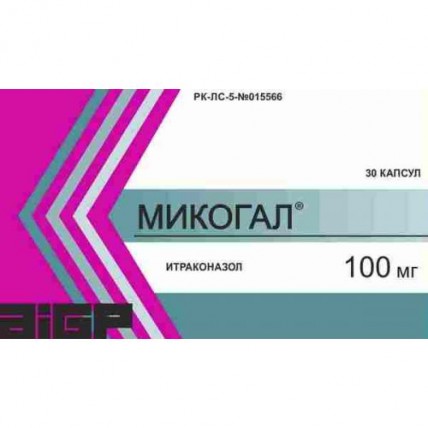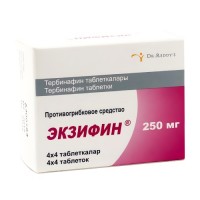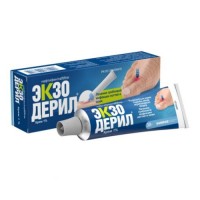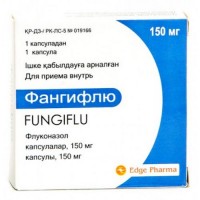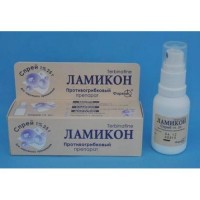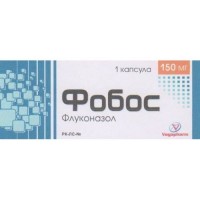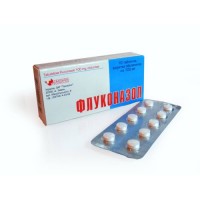Mikogal 30s 100 mg capsule
- $49.40
The instruction for medical use of Mikogal® medicine the Trade name of Mikogal® the International unlicensed name Itrakonazol Lekarstvennaya a form of the Capsule of 100 mg Structure One capsule contains active agent - itrakonazol 100 mg excipients: lactoses monohydrate, cellulose microcrystalline, magnesium stearate, silicon dioxide colloidal anhydrous, structure of the body and lid of capsule 1: FD&C Red No. 40 (E129), D&C Red No. 33, FD&C Yellow No. 6 (E 110), D&C Yellow No. 10 (E 104), titan dioxide (E 171), gelatin structure of the body and lid of capsule 2: FD&C Red No. 40 (E 129), the titan dioxide (E 171), gelatin, sodium lauryl sulfate, Karmoizin (E 122), the water purified the Description Solid gelatin capsules of red color. Capsule contents – powder of white color. Pharmacotherapeutic group Antifungal drugs for system use. Triazole derivatives. Itrakonazol the ATX J02AC02 Code the Pharmacological Pharmacokinetics General Pharmacokinetic Characteristics properties the Maximum concentration in plasma are reached within 2-5 hours after oral administration. The pharmacokinetics of an itrakonazol is not linear, respectively, drug collects in plasma after repeated reception. Equilibrium concentration in plasma are reached within 15 days with Cmax of 0.5 mkg/ml, 1.1 mkg/ml and 2.0 mkg/ml at oral administration of drug on 100 mg once a day, on 200 mg once a day and 200 mg twice a day, respectively. Final elimination half-life usually makes 16 – 28 hours at single dose and 34 – 42 hours at multiple dose. Concentration of an itrakonazol in blood plasma decreases to almost not defined value within 7 – 14 days, after the termination of therapy depending on the appointed dose and duration of treatment. At reception of an itrakonazol in higher doses its clearance decreases that is connected with saturability of systems of metabolism in a liver. Absorption Itrakonazol is quickly soaked up after oral administration. The maximum concentration of invariable medicine in plasma is reached within 2-5 hours after oral administration. Absolute level of bioavailability of an itrakonazol is about 55%. The oral bioavailability is maximum at reception of capsules after nourishing food. Absorption of an itrakonazol in capsules is reduced at patients with the lowered acidity of gastric juice, for example, against the background of administration of drugs suppressing secretion of hydrochloric acid in a stomach (such as antagonists of H2 - histamine receptors, inhibitors of a proton pomp), or at patients with an achlorhydria against the background of various diseases. Absorption of an itrakonazol on an empty stomach at such patients increases at administration of drug of Mikogal®, the capsule along with acid drinks (such as not dietary Coca). Exposure of an itrakonazol is lower at reception of an itrakonazol in the form of capsules in comparison with exposure of an itrakonazol at reception of the same dose in the form of solution for intake. Distribution the Overwhelming part of an itrakonazol of plasma is connected with proteins (99.8%), generally with albumine (99.6% for hydroxy metabolite). Also itrakonazol has the significant affinity to lipids. The free fraction of an itrakonazol in plasma makes only 0.2%. Distribution of an itrakonazol in an organism happens to the large seeming distribution volume (& gt, 700 l) that allows to assume intensive distribution in fabrics. Concentration of drug in lungs, kidneys, a liver, bones, a stomach, a spleen and muscles in two – three times are higher than the corresponding concentration in plasma, at the same time concentration of drug in the fabrics containing a keratin, especially in skin, approximately by 4 times exceeds concentration in plasma. Concentration in cerebrospinal fluid is much lower, than in blood plasma, nevertheless, the efficiency of an itrakonazol against causative agents of the infections which are present at cerebrospinal liquid was shown. Metabolism Itrakonazol is characterized by intensive metabolism in a liver as a result of which the large number of metabolites is formed. CYP3A4 is the main enzyme participating in metabolism of an itrakonazol. The main metabolite is the hydroxy-itrakonazol showing antifungal activity of in vitro in comparison with itrakonazoly. Concentration of hydroxy metabolite in plasma approximately is twice higher than the corresponding concentration of an itrakonazol. Removal Itrakonazol is removed mainly in the form of inactive metabolites with urine (35%) and a stake (54%) within one week after intake of solution for intake. Renal excretion of an itrakonazol and its active metabolite of a hydroksiitrakonazol is less than 1% of the dose of drug entered intravenously. On the basis of results of studying pharmacokinetics of 14C-marked drug after oral administration the removal of not changed itrakonazol with a stake varies from 3% to 18% of the accepted dose. Special groups of patients Patients with abnormal liver functions Itrakonazol is metabolized mainly by a liver. During the research of pharmacokinetics compared pharmacokinetic indicators of patients to cirrhosis and healthy volunteers. At patients with cirrhosis at single dose of 100 mg of an itrakonazol the average maximum concentration of an itrakonazol in plasma (Cmax) was much lower (for 47%), than at healthy patients. Average elimination half-life at reception of a single dose was increased at patients with cirrhosis and made in this research of 37+17 hours in comparison with 16+5 hours for healthy volunteers. Average exposure of an itrakonazol (the area under a curve concentration time - AUC) was similar at patients with cirrhosis and at healthy volunteers. Data on prolonged use of an itrakonazol at patients with cirrhosis are absent (see the sections Route of Administration and Doses and Special Instructions). Patients with renal failures Data on oral administration of an itrakonazol for treatment of patients with renal failures are limited. At patients with uraemia at whom the average clearance of creatinine was 13 ml/min. x 1.73 sq.m the system influence of an itrakonazol (AUC) was slightly lower in comparison with the main population. Considerable influence of the hemodialysis or long peritoneal dialysis which is carried out in out-patient conditions on indicators of pharmacokinetics of an itrakonazol is not revealed (Tmax, Cmax and AUC0-8ch). Data on long use of an itrakonazol by patients with renal failures are not available. Carrying out dialysis does not influence elimination half-life or clearance of an itrakonazol or hydroksiitrakonazol. A pharmacodynamics of Mikogal®-the synthetic antifungal broad-spectrum agent containing itrakonazol derivative triazole. The mechanism of action of an itrakonazol consists in inhibition of biosynthesis of ergosterol basic of a component of a cellular membrane of the mushroom participating in maintenance of structural integrity of a membrane. Disturbance of synthesis of ergosterol leads to change of permeability of a membrane and lysis of a cell that causes antifungal effect of drug. Itrakonazol is active concerning the infections caused by mushrooms of Blastomyces dermatitidis, Histoplasma capsulatum, Histoplasma duboisii, Aspergillus flavus, Aspergillus fumigatus, and Trichophyton spp. Candida krusei, Candida glabrata and Candida tropicalis are usually characterized by the smallest sensitivity to an itrakonazol from various strains of Candida, some of their isolates show unequal degree of resistance to an itrakonazol in the conditions of in vitro. It is possible to carry Zygomycetes to the main types of mushrooms which are not inhibited itrakonazoly (for example, Rhizopus spp., Rhizomucor spp., Mucor spp. and Absidia spp.), Fusarium spp., Scedosporium proliferans and Scopulariopsis spp. The resistance to antifungal drugs of an azolovy row develops slowly, often is a consequence of several genetic mutations. The installed mechanisms of development include supersynthesis of a gene of ERG11 coding the target enzyme 14α-demetilazu, dot mutations of a gene of ERG11 leading to decrease in affinity of drug to a target and/or supersynthesis of the carrier that leads to increase in an efflux. For Candida spp. the cross resistance between certain representatives of drugs of an azolovy row was defined though presence of resistance to one representative of a class does not mean obligatory resistance to other drugs. It was reported about itrakonazol-resistant strains of Aspergillus fumigatus. Indications · vulvovaginal candidiasis · chromophytosis · the dermatomycosis caused by the dermatophytes sensitive to an itrakonazol (Trichophyton spp., Microsporum spp., Epidermophyton floccosum), for example a dermofitiya of feet, a pakhovy dermatomycosis, a trunk dermofitiya, a dermatomycosis of hands and palms. · candidiasis of an oral cavity · the onychomycosis caused by dermatophytes and/or yeast · histoplasmosis · general fungus diseases, in cases when antifungal therapy of the first line was inexpedient, or it was inefficient. It can be connected with the latent pathology, insensitivity to pathogenic microorganisms or toxicity of medicine - aspergillomycosis and candidiasis - a cryptococcosis (including cryptococcal meningitis): to immunokompromitirovanny persons with a cryptococcosis and also to all patients with a cryptococcosis of the central nervous system - maintenance therapy at patients with AIDS, for prevention of a recurrence of the masked fungal infection It is shown for prevention of a fungal infection during a long neutropenia, in case of inexpediency of use of standard therapy the Route of administration and doses For optimum absorption of the MikogalÒ capsule have to be accepted right after nourishing food. Capsules have to be swallowed entirely. The scheme of treatment for adults depending on the indication: Indications the Note Dose Vulvovaginal candidiasis of 200 mg twice a day within 1 day the Chromophytosis of 200 mg once a day within 7 days of Dermofitiya of a trunk, a pakhovy dermatomycosis of 100 mg once a day within 15 days or 200 mg once a day within 7 days of Dermofitiya of feet, a dermatomycosis of hands and palms of 100 mg once a day within 30 days Orofaringealny candidiasis of 100 mg once a day within 15 days Gradual increase in a dose up to 200 mg once a day within 15 days for patients with the broken immunity (AIDS) or patients with a neutropenia because of reduced absorption of drug in these groups. The onychomycosis (nails on toes, with or without defeat of a nail plate) 200 mg once a day within 3 months In skin, vulvovaginal and oropharyngeal infections, optimum clinical and mycologic effect is reached in 1 - 4 weeks after the treatment termination, and at damage of nails, in 6 - 9 months after the treatment termination. It is caused by the fact that removal of an itrakonazol from skin, nails and mucous membranes happens more slowly, than removal of this substance from blood plasma. Treatment duration in system fungal infections is defined by mycologic and clinical reaction to therapy: Indications of the Indication Doza1 Doza1 of the Note of the Note Aspergillomycosis of 200 Mg raise the Dose to 200 mg twice a day in case of an invasive or disseminate disease once a day. Candidiasis of 100 - 200 mg the Dose is raised once a day to 200 mg twice a day in case of an invasive or disseminate disease. Not meningeal cryptococcosis of 200 mg once a day See the section Special Instructions Cryptococcal meningitis of 200 mg twice a day Histoplasmosis of 200 mg once a day - 200 mg twice a day Maintenance therapy at patients with AIDS of 200 mg once a day See below the note on absorption disturbance the Prevention of a neutropenia of 200 mg See below the note on absorption disturbance 1 Duration of treatment has to be adjusted once a day depending on clinical reaction. Disturbance of absorption at patients with AIDS and patients with a neutropenia can lead to the low level of an itrakonazol in blood and insufficient efficiency from treatment. In such cases the monitoring of indicators of blood, and, if necessary, increase in a dose of an itrakonazol up to 200 mg twice a day is shown. Use for elderly patients As is not enough data on use of the drug Mikogal® for elderly patients, it is not recommended to appoint it to elderly patients, except for cases when the expected advantage exceeds possible risk. The drug dose for elderly patients has to be established, in view of disturbances of functions of kidneys, liver or heart and also presence of associated diseases or passing of other drug treatment. Use for patients with a renal failure the Data on use of oral dosage forms of an itrakonazol for patients with a renal failure are limited. Extent of influence of an itrakonazol can be lower at some patients with a renal failure. When prescribing this drug the patients with renal insufficient need to observe extra care. Correction of a dose has to be carried out depending on a specific case. Use for patients with a liver failure the Data on use of oral dosage forms of an itrakonazol for patients with a liver failure are limited. Treatment of the considered group of patients has to be carried out with care. Side effect In the list given below side effects depending on a system and organ class are provided. In each system and organ class side reactions depending on the frequency of their emergence are provided: very often (≥ 1/10), it is frequent (≥ 1/100 to & lt, 1/10), infrequently (≥ 1/1,000 to & lt, 1/100), is rare (≥ 1/10,000 to & lt, 1/1,000), is very rare (& lt, 1/10,000). Infectious and parasitic diseases: rhinitis, pharyngitis, sinusitis, Disturbance upper respiratory tract infections from the haematogenic and lymphatic systems: a leukopenia, a neutropenia, thrombocytopenia, an anaphylaxis, anaphylactic, anaphylactoid and allergic reactions, a serum disease, a Quincke's disease of Disturbance from nervous system: a headache, dizziness, peripheral neuropathy, paresthesia, a gipoesteziya, the Disturbance tremor from an organ of sight: a visual disturbance, including illegibility and ambiguity of sight, the Disturbance diplopia from an organ of hearing and balance: a passing or constant hearing loss, a ring in Disturbance ears from a cardiovascular system: stagnant heart failure, insufficiency of a left ventricle, tachycardia, arterial hypotension, an arterial hypertension, the Disturbance vasculitis from the respiratory system, bodies of a thorax and mediastinum: a fluid lungs, short wind, a dysphonia, Disturbance cough from digestive tract: pancreatitis, a disgeziya, dyspepsia, a constipation, a meteorism, diarrhea, vomiting, an abdominal pain, Disturbance anorexia from a liver and biliary tract: a hyperbilirubinemia, an abnormal liver function, serious hepatotoxicity (including separate cases from the death from an acute liver failure), hepatitis, Disturbance jaundice from a metabolism: hyperglycemia, hyperpotassemia, hypopotassemia, hypomagnesiemia, gipertriglitseridemiya of Disturbance of mentality: confusion of consciousness, drowsiness, decrease a libido, a depression, the Disturbance asthenia from skin and hypodermic fabrics: a toxic epidermal necrolysis, Stephens-Johnson's syndrome, sharp generalized exanthematous pustulez, a mnogoformny erythema, exfoliative dermatitis, a leykotsitoklastichesky vasculitis, an alopecia, photosensitivity, a small tortoiseshell, rash, eritematoz, the Disturbance hyperhidrosis from skeletal and muscular and connective tissue: the Disturbance arthralgia from kidneys and urinary tract: insufficiency of function of kidneys, a pollakiuria, an albuminuria Disturbance from genitals and a mammary gland: erectile dysfunction, disturbance of a menstrual cycle, a gynecomastia the General disorders and disturbances in the injection site: peripheral hypostasis, face edema, stethalgia, fever, fatigue, fever Influence on results of laboratory indicators and tool researches: increase in a kreatinfosfokinaza in blood, increase in activity of alaninaminotranspherase, increase in activity of aspartate aminotransferase, increase in activity of alkaline phosphatase in blood plasma, increase in activity of a lactate dehydrogenase in blood plasma, increase in concentration of urea of blood, increase in activity gamma glutamiltransferazy, increase in activity of liver enzymes, an aberration to a pokazata
to it the general analysis of urine of the Contraindication · The drug MikogalÒ is contraindicated to patients with the known hypersensitivity to an itrakonazol or to any excipients - during the Mikogal® drug treatment the intake of CYP3A4 substrates is contraindicated. The increased concentration of the above-stated drugs in blood plasma because of their combined use with itrakonazoly, can strengthen or prolong both therapeutic action, and side effects of these medicines which can provoke emergence potentially life-threatening a state. For example, the increased concentration of the above-stated drugs in blood plasma can lead to increase in an interval of QT and also to a ventricular tachyarrhythmia including cases of ventricular tachycardia like 'pirouette' or potentially fatal arrhythmia. · The Mikogal® capsules should not be appointed to patients with symptoms of ventricular dysfunction, for example, with the stagnant heart failure (SHF) or the anamnesis of ZSN, except for cases of treatment of zhizneugrozhayushchy or other serious infections. · The Mikogal® capsules should not be accepted during pregnancy except for cases, life-threatening · The women of childbearing age accepting Mikogal® have to use appropriate methods of contraception. Effective contraception has to be continued also during the first menstrual period after completion of the Mikogal® drug treatment. · The children's and teenage age up to 18 years Medicinal interactions Itrakonazol is mainly metabolized by CYP3A4 isoenzyme. Other medicines which it is also metabolized with participation of this isoenzyme or change its activity, can influence pharmacokinetics of an itrakonazol. In a similar way, itrakonazol can influence pharmacokinetics of medicines which are also metabolized with the participation of this isoenzyme. Itrakonazol treats strong inhibitors of an isoenzyme CYP3A4 and P-glycoprotein. When using an itrakonazol together with other medicines it is recommended to study the instruction for use for clarification of a way of metabolism of drug and the solution of a question of need of change of its dose. Medicines which can reduce concentration of an itrakonazol in blood plasma the Medicines reducing acidity of gastric juice (for example, antiacid means, such as aluminum hydroxide, or means suppressing secretion of hydrochloric acid, such as antagonists of H2 - histamine receptors and inhibitors of a proton pomp) break absorption of the drug Mikogal®, the capsule. These medicines are recommended to be used with care in combination with the drug Mikogal®, capsules: · Itrakonazol is recommended to accept together with acid drinks (such as not dietary Coca) when sharing the medicines reducing acidity of gastric juice. · It is recommended to take the medicines neutralizing hydrochloric acid (for example, aluminum hydroxide), at least in 1 hour prior to or in 2 hours after administration of drug of Mikogal®, the capsule. · At joint intake of medicines it is recommended to control antifungal activity of an itrakonazol and to increase a drug dose at need emergence. Combined use of an itrakonazol with strong inductors of an isoenzyme CYP3A4 can promote decrease in bioavailability of an itrakonazol and hydroksiitrakonazol to such an extent that the efficiency of medicine will decrease substantially. Examples include the following drugs: • Antibacterial agents: isoniazid, rifabutin, rifampicin. • Anticonvulsant drugs: carbamazepine, phenobarbital, Phenytoinum. • Antiviral drugs: efavirenz, not Virapinum. Thus, use of strong inductors of an isoenzyme of CYP3A4 together with itrakonazoly is not recommended. It is recommended to avoid prescribing of these medicines within two weeks prior to reception of an itrakonazol and during drug treatment, except for cases when the expected advantage exceeds the potential risk connected with decrease in efficiency of an itrakonazol. At joint intake of medicines it is recommended to control antifungal activity of an itrakonazol and to increase a drug dose at need emergence. The Concomitant use of an itrakonazol and strong inhibitors of an isoenzyme CYP3A4 can lead medicines which can cause increase in concentration of an itrakonazol in blood plasma to increase in bioavailability of an itrakonazol. Examples of strong inhibitors of an isoenzyme of CYP3A4: • Antibacterial drugs: ciprofloxacin, klaritromitsin, erythromycin. • Antiviral means: darunavir, strengthened ritonaviry, fosamprenavir, strengthened ritonaviry, indinavir, ritonavir. These medicines are recommended to be used with care together with itrakonazoly. It is recommended to control carefully a condition of the patients accepting itrakonazol together with strong inhibitors of an isoenzyme CYP3A4 for early detection of symptoms and signs of strengthening or prolongation of iyerapevtichesky effects of an itrakonazol, if necessary the dose decline of an itrakonazol is possible. It is whenever possible recommended to control concentration of an itrakonazol in blood plasma. Medicines which concentration in blood plasma can increase when sharing with itrakonazoly Itrakonazol and his main metabolite hydroksiitrakonazol can break metabolism of medicines, metaboliziruyemy an isoenzyme of CYP3A4 and interfere with transportation of drugs under the influence of a P-glycoprotein. It can lead to increase in plasma concentration of these medicines and/or their active metabolites at joint reception with itrakonazoly. Increase in plasma concentration, in turn, can cause strengthening or prolongation of both therapeutic, and undesirable effects of these medicines therefore there can be potentially life-threatening states. So, increase in concentration of some drugs can lead to increase in an interval-QT and ventricular tachyarrhythmia, including cases of ventricular tachycardia like 'pirouette' which belongs to potentially life-threatening states. After the treatment termination the plasma concentration of an itrakonazol decreases to almost indefinable within from 7 to 14 days, depending on a dose of drug and duration of treatment. At patients with cirrhosis or those who at the same time accept CYP3A4 enzyme inhibitors decrease in concentration of drug can be even slower. It is especially important during the beginning of performing therapy with use of medicines which metabolism influences itrakonazol. The interacting medicines are subdivided into the following categories: - Are contraindicated: not under what circumstances it is impossible to use this medicine in a combination with itrakonazoly and within two weeks after the termination of reception of an itrakonazol. - It is not recommended: it is recommended to avoid use of this medicine during treatment and within two weeks after the termination of reception of an itrakonazol, except for cases when the expected advantage exceeds the potential risk connected with the carried-out therapy. If it is impossible to avoid use of this combination of medicines, it is recommended to watch a condition of the patient for early detection of symptoms and signs of strengthening or prolongation of effects of drugs or development of side effects, in case of need treatment it is possible to interrupt or reduce a dose of medicines. In the presence of an opportunity it is recommended to control plasma concentration of drugs. - To use with care: it is necessary to carry out careful monitoring when sharing medicine with itrakonazoly. When sharing medicines it is recommended to watch a condition of the patient for early detection of symptoms and signs of strengthening or prolongation of effects of drugs or development of side effects, in case of need treatment it is possible to interrupt or reduce a dose of medicines. In the presence of an opportunity it is recommended to control plasma concentration of drugs. Examples of medicines which plasma concentration can increase under the influence of an itrakonazol are given below. Drugs are divided on classes, recommendations about combined use with itrakonazoly are also made: A class of medicines Are contraindicated analgetics are not recommended to Use with care Tamsulozin Narkoticheskiye Alpha adrenoblockers the levatsetilmeta-dale (levometadit), methadone fentanyl alfentanil, buprenorphine for intravenous and sublingual administration, oxycodone Antiarrhytmic means Disopyramidum, dofetilid, dronedaron, quinidine digoxin Antibacterial agents of a rifabutin Anticoagulants and antiagregant rivaroksaban coumarins, tsilostazol, dabigatran Anticonvulsant drugs of carbamazepine Antidiabetic drugs repaglinid, saksagliptin Protivogelmintny and anti-protozoan means galofantrin a praziquantel Antihistaminic drugs astemizol, mizolastin, terfenadin ebastin Drugs against migraine ergot alkaloids, such as digidro-ergotamine, ergometrine (ergonovin), ergotamine methylergometrine (metilergono-wines) eletriptan Antineoplastic drugs irinotekan dazatinib, nilotinib, trabektedin bortezomib, buzulfan, dotsetakset, erlotinib, iksabepilon, lapatinib, trimetreksat, periwinkle alkaloids Neuroleptics, anxiolytics and sleeping medicines lurasidon, midazolam for oral administration, Pimozidum, sertindol, to triazoles to alprazola, aripiprazol, brotiozolam, buspiron, a haloperidol, midazolam for intravenous administration, perospiron, kvetiapin, ramelteon, risperidon Antiviral drugs a maravirok, indinavirb, ritonavirb, sakvinavir Beta blockers Nadololum Blockers of slow calcium channels bepridit, felodipin, lerkanidipin, nisoldipin other dihydropyridines, including verapamil ranolazin aliskiren Diuretics eplerenon & l
to Develop Other drugs operating on a cardiovascular system ivabradin
to it the general analysis of urine of the Contraindication · The drug MikogalÒ is contraindicated to patients with the known hypersensitivity to an itrakonazol or to any excipients - during the Mikogal® drug treatment the intake of CYP3A4 substrates is contraindicated. The increased concentration of the above-stated drugs in blood plasma because of their combined use with itrakonazoly, can strengthen or prolong both therapeutic action, and side effects of these medicines which can provoke emergence potentially life-threatening a state. For example, the increased concentration of the above-stated drugs in blood plasma can lead to increase in an interval of QT and also to a ventricular tachyarrhythmia including cases of ventricular tachycardia like 'pirouette' or potentially fatal arrhythmia. · The Mikogal® capsules should not be appointed to patients with symptoms of ventricular dysfunction, for example, with the stagnant heart failure (SHF) or the anamnesis of ZSN, except for cases of treatment of zhizneugrozhayushchy or other serious infections. · The Mikogal® capsules should not be accepted during pregnancy except for cases, life-threatening · The women of childbearing age accepting Mikogal® have to use appropriate methods of contraception. Effective contraception has to be continued also during the first menstrual period after completion of the Mikogal® drug treatment. · The children's and teenage age up to 18 years Medicinal interactions Itrakonazol is mainly metabolized by CYP3A4 isoenzyme. Other medicines which it is also metabolized with participation of this isoenzyme or change its activity, can influence pharmacokinetics of an itrakonazol. In a similar way, itrakonazol can influence pharmacokinetics of medicines which are also metabolized with the participation of this isoenzyme. Itrakonazol treats strong inhibitors of an isoenzyme CYP3A4 and P-glycoprotein. When using an itrakonazol together with other medicines it is recommended to study the instruction for use for clarification of a way of metabolism of drug and the solution of a question of need of change of its dose. Medicines which can reduce concentration of an itrakonazol in blood plasma the Medicines reducing acidity of gastric juice (for example, antiacid means, such as aluminum hydroxide, or means suppressing secretion of hydrochloric acid, such as antagonists of H2 - histamine receptors and inhibitors of a proton pomp) break absorption of the drug Mikogal®, the capsule. These medicines are recommended to be used with care in combination with the drug Mikogal®, capsules: · Itrakonazol is recommended to accept together with acid drinks (such as not dietary Coca) when sharing the medicines reducing acidity of gastric juice. · It is recommended to take the medicines neutralizing hydrochloric acid (for example, aluminum hydroxide), at least in 1 hour prior to or in 2 hours after administration of drug of Mikogal®, the capsule. · At joint intake of medicines it is recommended to control antifungal activity of an itrakonazol and to increase a drug dose at need emergence. Combined use of an itrakonazol with strong inductors of an isoenzyme CYP3A4 can promote decrease in bioavailability of an itrakonazol and hydroksiitrakonazol to such an extent that the efficiency of medicine will decrease substantially. Examples include the following drugs: • Antibacterial agents: isoniazid, rifabutin, rifampicin. • Anticonvulsant drugs: carbamazepine, phenobarbital, Phenytoinum. • Antiviral drugs: efavirenz, not Virapinum. Thus, use of strong inductors of an isoenzyme of CYP3A4 together with itrakonazoly is not recommended. It is recommended to avoid prescribing of these medicines within two weeks prior to reception of an itrakonazol and during drug treatment, except for cases when the expected advantage exceeds the potential risk connected with decrease in efficiency of an itrakonazol. At joint intake of medicines it is recommended to control antifungal activity of an itrakonazol and to increase a drug dose at need emergence. The Concomitant use of an itrakonazol and strong inhibitors of an isoenzyme CYP3A4 can lead medicines which can cause increase in concentration of an itrakonazol in blood plasma to increase in bioavailability of an itrakonazol. Examples of strong inhibitors of an isoenzyme of CYP3A4: • Antibacterial drugs: ciprofloxacin, klaritromitsin, erythromycin. • Antiviral means: darunavir, strengthened ritonaviry, fosamprenavir, strengthened ritonaviry, indinavir, ritonavir. These medicines are recommended to be used with care together with itrakonazoly. It is recommended to control carefully a condition of the patients accepting itrakonazol together with strong inhibitors of an isoenzyme CYP3A4 for early detection of symptoms and signs of strengthening or prolongation of iyerapevtichesky effects of an itrakonazol, if necessary the dose decline of an itrakonazol is possible. It is whenever possible recommended to control concentration of an itrakonazol in blood plasma. Medicines which concentration in blood plasma can increase when sharing with itrakonazoly Itrakonazol and his main metabolite hydroksiitrakonazol can break metabolism of medicines, metaboliziruyemy an isoenzyme of CYP3A4 and interfere with transportation of drugs under the influence of a P-glycoprotein. It can lead to increase in plasma concentration of these medicines and/or their active metabolites at joint reception with itrakonazoly. Increase in plasma concentration, in turn, can cause strengthening or prolongation of both therapeutic, and undesirable effects of these medicines therefore there can be potentially life-threatening states. So, increase in concentration of some drugs can lead to increase in an interval-QT and ventricular tachyarrhythmia, including cases of ventricular tachycardia like 'pirouette' which belongs to potentially life-threatening states. After the treatment termination the plasma concentration of an itrakonazol decreases to almost indefinable within from 7 to 14 days, depending on a dose of drug and duration of treatment. At patients with cirrhosis or those who at the same time accept CYP3A4 enzyme inhibitors decrease in concentration of drug can be even slower. It is especially important during the beginning of performing therapy with use of medicines which metabolism influences itrakonazol. The interacting medicines are subdivided into the following categories: - Are contraindicated: not under what circumstances it is impossible to use this medicine in a combination with itrakonazoly and within two weeks after the termination of reception of an itrakonazol. - It is not recommended: it is recommended to avoid use of this medicine during treatment and within two weeks after the termination of reception of an itrakonazol, except for cases when the expected advantage exceeds the potential risk connected with the carried-out therapy. If it is impossible to avoid use of this combination of medicines, it is recommended to watch a condition of the patient for early detection of symptoms and signs of strengthening or prolongation of effects of drugs or development of side effects, in case of need treatment it is possible to interrupt or reduce a dose of medicines. In the presence of an opportunity it is recommended to control plasma concentration of drugs. - To use with care: it is necessary to carry out careful monitoring when sharing medicine with itrakonazoly. When sharing medicines it is recommended to watch a condition of the patient for early detection of symptoms and signs of strengthening or prolongation of effects of drugs or development of side effects, in case of need treatment it is possible to interrupt or reduce a dose of medicines. In the presence of an opportunity it is recommended to control plasma concentration of drugs. Examples of medicines which plasma concentration can increase under the influence of an itrakonazol are given below. Drugs are divided on classes, recommendations about combined use with itrakonazoly are also made: A class of medicines Are contraindicated analgetics are not recommended to Use with care Tamsulozin Narkoticheskiye Alpha adrenoblockers the levatsetilmeta-dale (levometadit), methadone fentanyl alfentanil, buprenorphine for intravenous and sublingual administration, oxycodone Antiarrhytmic means Disopyramidum, dofetilid, dronedaron, quinidine digoxin Antibacterial agents of a rifabutin Anticoagulants and antiagregant rivaroksaban coumarins, tsilostazol, dabigatran Anticonvulsant drugs of carbamazepine Antidiabetic drugs repaglinid, saksagliptin Protivogelmintny and anti-protozoan means galofantrin a praziquantel Antihistaminic drugs astemizol, mizolastin, terfenadin ebastin Drugs against migraine ergot alkaloids, such as digidro-ergotamine, ergometrine (ergonovin), ergotamine methylergometrine (metilergono-wines) eletriptan Antineoplastic drugs irinotekan dazatinib, nilotinib, trabektedin bortezomib, buzulfan, dotsetakset, erlotinib, iksabepilon, lapatinib, trimetreksat, periwinkle alkaloids Neuroleptics, anxiolytics and sleeping medicines lurasidon, midazolam for oral administration, Pimozidum, sertindol, to triazoles to alprazola, aripiprazol, brotiozolam, buspiron, a haloperidol, midazolam for intravenous administration, perospiron, kvetiapin, ramelteon, risperidon Antiviral drugs a maravirok, indinavirb, ritonavirb, sakvinavir Beta blockers Nadololum Blockers of slow calcium channels bepridit, felodipin, lerkanidipin, nisoldipin other dihydropyridines, including verapamil ranolazin aliskiren Diuretics eplerenon & l
to Develop Other drugs operating on a cardiovascular system ivabradin
